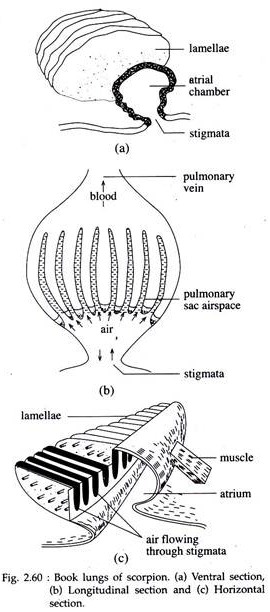In this article we will discuss about the Respiration in Scorpion:- 1. Respiratory Structure in Scorpion 2. Mechanism of Respiration in Scorpion.
Respiratory Structures in Scorpion:
This oldest land-living arthropod belongs to the class Arachnida. The scorpions are usually inhabitants of deserts, mountainous areas or rain forests. They are nocturnal and spend daytime within sands, crevices, holes, and under logs and stones. The respiratory organs of scorpion are known as book lungs. Four pairs of stigmata/spiracles also help in respiration.
Book Lungs:
Book lungs are primitive respiratory organs and are modified from book-gills. However, in contrast to book gills of prawn, book lungs are internal and an adaptation associated with the migration of arachnids to a terrestrial environment.
ADVERTISEMENTS:
In scorpions, four pairs of book lungs, one pair in each of the third, fourth, fifth and sixth meso-somatic segments are present. These are placed within special chambers called pulmonary sacs. In embryos, the book lungs originate externally from the ectoderm but in adults, these are tucked in and are finally lodged within the inner pulmonary sacs.
Each book lung has two parts — a small, anterior, ventral atrial chamber that opens to the exterior through the stigmata, and a posterior pulmonary chamber that houses the book lung itself. Each such book lung consists of nearly 140 vertically folded leaves or lamellae with chitinous lining (Fig. 2.60a, b). These lamellae are the respiratory surfaces.
The edges of the leaves remain attached with the wall of the pulmonary sac by one end, while the other end remains free. Each lamella contains a hollow cavity, through which blood flows. In between two lamellae, lies a thin air space.
All these spaces communicate with a central chamber called atrium or atrial chamber which opens to the exterior by spiracle. Cuticular bars are present in between two lamellae which prevents the lamellae from collapsing. The venous blood comes from the ventral sinus and enters the lamellae through a diverticulum. The oxygenated blood IS collected by the pulmonary veins and enters into the pericardium.
ADVERTISEMENTS:
Stigmata/Spiracle:
The book lungs open to the exterior by means of four pairs of spiracles, situated on each side of the ventral surface of third, fourth, fifth and sixth meso- soma. These spiracles control the inspiration and expiration in scorpion (Fig. 2.60a and b).
Mechanism of Respiration in Scorpion:
Contraction and relaxation of special set of muscles called dorsoventral muscles and atrial muscles help the air to rush in and out of the book lungs, when the book lungs are relaxed, air rushes inside through stigmata to the atrial chamber and inter-lamellar spaces (Fig. 2.60b & c).
When the muscles contract, the book lungs expel the air out. The diffusion of gases occurs in the inter-lamellar spaces between the air and venous blood. During normal activities, the spiracles try to remain closed so that least amount of water vapour comes out of the book lungs.
ADVERTISEMENTS:
But the spiracles open fully during active movement of the animal. In scorpion, the respiratory pigment is haemocyanin that carry the oxygen to the tissue cells.
